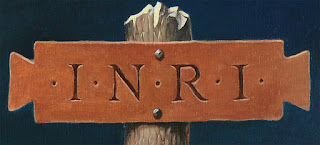“The royal banners forward go...”
Legend has it that the Lenten hymn containing this phrase was written by Venantiaus Fortunatus to accompany a grand processional. The momentous event occurred in late 568 A.D. at Poitiers, when a supposed relic of the true cross was being presented to the church there. Fortunatus was given the distinction of formally receiving it, so it was that he and a contingent of dignitaries processed while singing the hymn.
 |
| "Resurrection" (Detail of fresco of "Scenes from the Life of Christ." Giotto. 1304-1306. (Capella Scrovegni, Padua, Italy) |
That legend slightly soils my appreciation for the hymn, but one would otherwise find it hard to stretch a Scriptural metaphor out of the title line. I seriously doubt royal banners were employed at common executions in Roman-occupied Jerusalem. Furthermore, Christians might view the cross of Christ as a singular royal banner, but not a multitude of them.
In sacred art, royal banners do appear, but not usually during the crucifixion of Jesus. The Resurrection is an entirely different matter. Banners became the rule in depictions of the Resurrection by the time the Proto-Renaissance rolled around, and it is Jesus Christ who carries them.
Origins of Christ holding a white banner emblazoned with a red cross are hard to find in Orthodox imagery. Oldest formulae in Orthodoxy show the resurrected Christ yanking Adam and Eve out of their graves. He pulls so hard at them that one wonders at the soundness of their rotator cuffs. When icons do give Jesus a free hand, He sometimes holds a staffed cross. Only in modern Eastern icons and Coptic icons do banners occasionally show up.
 |
| "Harrowing of Hell" Martin Schongauer. 1480s. (National Library of Russia, St. Petersburg) |
The Florentine artist, Giotto, was one of the earliest to depict the risen Christ with a resurrection banner. Soon others followed his lead, and it became a familiar pattern as the renaissance spread northward. But why the banner?
The answer doesn’t necessarily have to do with a living Christ. It points, instead, to the place from whence He just emerged. Holy Scripture briefly describes this in 1 Peter 3:18-20 – specifically with the phrase, “...He went and proclaimed to the spirits in prison.” He might have been proclaiming and preaching in hell, but it was a sermon of fire and brimstone and not much else. Christ descended into hell to proclaim victory over Satan and his minions. The banner is a victory flag.
One must be extremely careful to not read purgatorial nonsense into the passage of 1 Peter. Many have, and the result has created a whole genre of “the harrowing of hell,” which is Scriptural in name only. There is enough art to further the heresy. The Example by Schongauer, along with many similar images, borrows a motif from orthodox imagery and applies it incorrectly to Christ's visit to hell, showing Christ pulling “saints” out of hell. Scripture simply does not say that folks get a second chance after they are dead and gone. It doesn’t happen.
 |
| "Resurrection of Christ with Donor Family" Lucas Cranach the Younger. c. 1573. (Private collection) |
But the resurrection DID happen, and it was a banner day for all believers. Remember that the next time you see a depiction of Jesus Christ – or the Lamb of God – holding a banner. It symbolizes that He has conquered sin, death, and hell, and has firmly rubbed Satan's nose in that fact.













